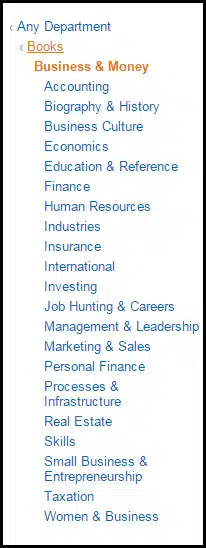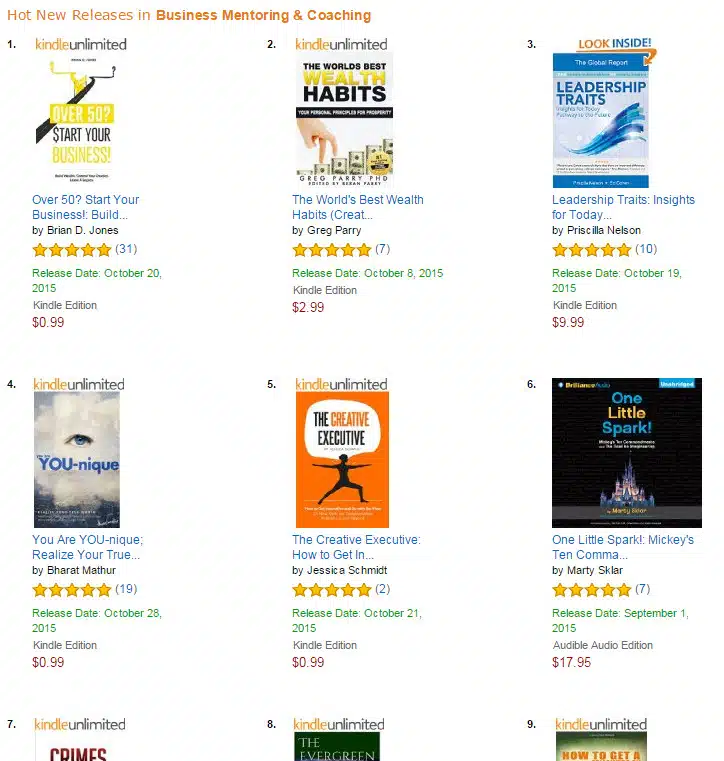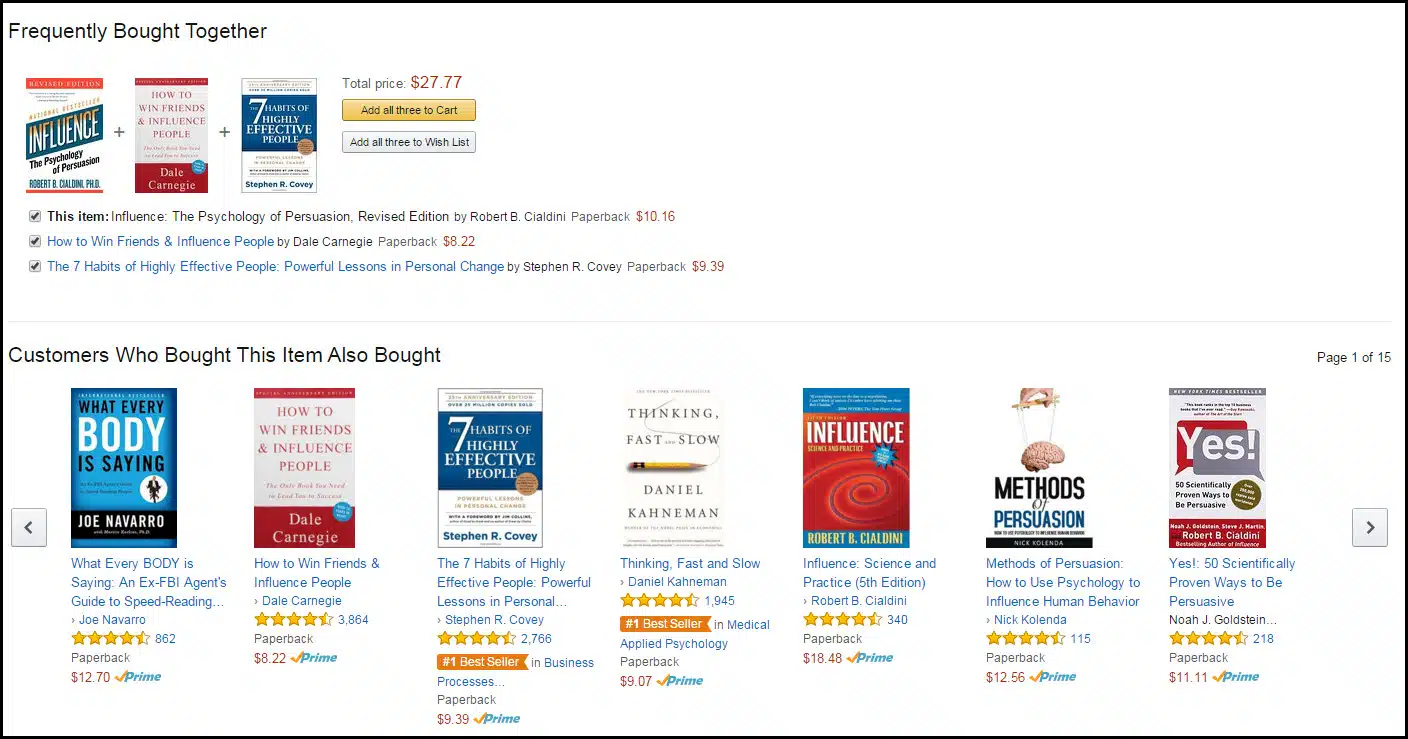Looking for the next great business opportunity in your market niche? Short on ideas for content or products to create? Trying to decide what business you want to go into in the first place?
There's no reason you should ever be short on ideas, especially with the internet and social media.
But in this post, I'm going to focus on a less obvious tool than a simple Google search. I'm talking about amazon.com.
Amazon has a wealth of data you can tap into. And…
It's all freely available, if you know how to look.
You can learn about trending topics, micro-niches within markets, problems not solved, needs not being met, cross selling possibilities, title ideas, keyword ideas, what your customers are wishing for, and all sorts of other information.
For now, I'm going to focus on 7 different ways you can use amazon to discover new niches, learn more about your niche, and get ideas for different aspects of your business.
When you start using all these different secrets, be sure to take notes throughout your searches. You'll be getting a million ideas and bits of market intelligence, so I suggest creating a notebook (paper or Evernote) to keep track. If you use Evernote, you could even create a notebook for each market and ‘clip' key webpages to your notebook for easy reference later.
1. Get Ideas for Markets
Amazon sells pretty much everything, and they do it well. But that also means they have to make it easy for shoppers to find what they want. The result is a vast categorization of topics that you can take advantage of for discovering niche opportunities.
If you have no ideas at all to start with, you can begin at the very beginning and look at overall bestsellers on amazon:

See if there are any topics that jump out at you. You can click on it to see which major category it falls into. Start with one before getting drawn down the rabbit hole of all the interesting markets you could enter.
Hold on to that link. If you look at the top tabs, you'll see categories for the following:
- Hot New Releases
- Movers & Shakers
- Top Rated
- Most Wished For
- Gift Ideas
You can filter by department for any of those categories and they'll give you valuable information about what's trending in any one market. For this article, I'll focus primarily on all the information you can get by browsing through the bestsellers section on amazon, but go ahead and spend time exploring other parts of the site as well.
2. Get Ideas for Niches
With all those categories, you'll have to start drilling down right away if you want to find your niche. Amazon has already broken down the categories into the most common niches people look for.
- Start by picking one Department that relates to your market.
For people selling information or coaching, I suggest going straight to Books. I love looking at the Books department because it tells me what people want to learn about most on different topics.
- First look at the bestsellers again to see which niches are getting the most attention. For example, here are the bestsellers in books at the moment:

Can you see number 5? It's all about The Life Changing Magic of Tidying Up. If that's the number 5 best-selling topic in all of Books on amazon, then one popular niche you could consider is personal organization.
- Now browse through sub-categories within a larger category to get ideas for niches you could enter. You can find the list of sub-categories over on the left side in the image above. Just click through any of those to see how amazon divides up the sub-categories in each section. For example, here are the sub-categories in Business & Money:

You can click on any of those to drill down to more sub-categories. But when you get to a sub-category that has very few topics or products, you may have narrowed your search too much. At that point, you're probably only going to get ideas for content (which I'll talk about in a moment).
3. Spy on Your Potential Competitors
Know what you're getting into if you think you want to go after a big market. Who are you going to be competing against? What are they selling? Or, in the case of information, what are they teaching or espousing?
- Look at the top sellers in your categories and who's selling it. For some, there will be a company page or author page you can check out to learn more. For example, here's part of the bestsellers page for Women & Business, which is a sub-category of Business & Money in Books:

You can see that several of the top-selling books are versions of a book by Sheryl Sandberg called Lean In: Women, Work, and the Will to Lead.
- For something like an information product (books), take a look at what your top competitors are writing about or teaching. You should be able to click through to the table of contents and some sample pages for many books.
For example, when you click through to Lean In, you'll see that the book cover says ‘Look Inside‘ above it. Click on the book cover and you'll get a pop-up box that lets you explore a few pages in the book, including the Table of Contents:

Just reading the titles of chapters will give you a few ideas of what the author is talking about and emphasizing, as well as what topics are probably popular in that niche. If it's a bestseller, you can be sure there's a big market that's interested in those topics.
In the example above, you can see that the author is talking about fear, likeability, mentors, speaking your truth, the role of your partner in your success, trying to do it all, working together with other women, etc. Those all sound like great topics for sub-niches as well as content.
Don't try doing exactly what your competitors are doing, but use the information to show you what's popular and where you could spend time figuring out different value you could offer. Remember, you need to be yourself!
4. Brainstorm Product/Service/Content /Title Ideas
This is my all-time favorite way to use amazon. The more you browse through a category, the more ideas you'll get. By the time you're done, you could easily have a big list of products you want to create, courses you want to teach, blog posts and emails to write, and titles of new books to write. Keep that list safe!
Here are just a few places to look for ideas:
- Sub-categories
- Top Sellers
- Products with a high number of reviews (indicates interest and passion for a topic)
- What's Hot (eg topics in time management; trends)
- Table of Contents in top selling books
For example, take a look at all the sub-categories in Management & Leadership:

And if you look over on the right of your results, you can click on Hot New Releases. Here's what's hot in Business Mentoring & Coaching (at the time I'm writing this – it changes frequently):

See that first one? It's all about starting a business when you're over 50. Now that's what I call a good, targeted niche! Click through to Look Inside and find the Table of Contents. Now you have ideas for things to write about in that niche.
If you already have a customer base or email list, or you know people who are in your target market, you have another tool you can use for ideas:
The Wish List
You can look up any person's wish list and see just what topics or products they're hoping to buy. If they spent the time to add it to their list, there's probably a high level of interest that you could potentially fulfill.
Or, you can look at what's Most Wished For to see what the general population wants in that category. Sometimes amazon embeds that right into your search results:

5. Find Niche Keywords and Phrases
You can be relatively safe in assuming that the keywords and phrases on amazon are the ones that people are using in their searches.
That means that you can borrow those keywords and use them in your own content, such as blog posts, categories and sub-categories on your site, and in product descriptions. Actually, use them anywhere people might search for your content – your website, products, videos, slideshows, social media posts, etc.
- Look at the names of the categories on amazon
- Names of subcategories
- Key phrases in the descriptions of top-ranking results
For example, if you scroll back up in this post, you'll find a number of keywords from the subcategories of Management & Leadership. Or take a look at the even smaller list of sub-categories in Marketing & Sales:

Those are category keywords, so you'd need to drill down further to get longer keyword phrases. Just don't assume that the words used for all products are good keywords. You should still use a keyword tool to generate more ideas and see what the competition is.
6. Estimate Niche Profitability
There are a few ways you can use amazon's content to determine if your niche idea is going to be profitable in the long term.
- Look at the number of products in your category. Are there thousands, or just a handful?
- How many sub-categories are there in your main category niche? If there aren't any, or if there are only one or two, then you may have hit the bottom of the bucket. Your niche just may be too narrow and limited for long term growth. Alternatively, amazon just hasn't found it necessary to divide the categories up further. Keep researching.
- What are amazon's recommended upsells/cross-sells/combos (frequently bought together, customers also bought)? If there are a lot of options there, chances are that people buy multiple products in your category. That means people are spending money and there is growth potential for you.
- Are the products in you niche repeat purchases? Or are they one-off items? Anything that people buy over and over can mean income in the long term
- What are the different price points of products? If people are buying items for $100 and up, there's a good chance that they'll be willing to spend more
For example, when I clicked on the book Influence: The Psychology of Persuasion, by Robert Cialdini, I scrolled down to see the Frequently Bought Together and Customers Who Bought This Also Bought sections:

That tells me that people who purchase items related to the pyschology of persuasion in the Marketing & Consumer Behavior category buy a LOT of books. There are over 100 in the section of what people also bought.
If you look at some of those ‘also bought' books and what categories they fall into, you'll also get ideas for topics related to your niche that you could potentially expand into. For example, one of the ‘also bought' books above is on negotiation, which is definitely related to influence.
Take notes on all the data you find here since it's a combination of all of it, plus other market research, that will help you assess profitability. Don't rely solely on amazon for your data!
7. Uncover Untapped Markets
I've saved the best for last. This is a secret trick that takes more time, but it can yield some unexpected and surprising insights on your market's needs.
The trick is to look at the reviews of top selling products in your best niches. It's here that you can find the unmet needs and opportunities. You'll also find out what's most important to your customers.
- Look for top selling products in your category with higher number of reviews
- Look first at the ‘Most helpful' reviews. These are reviews that browsers found most helpful in making their decision about buying the product, which means they are probably more than just a rant.
- Read poor review ratings. What are people saying? What are they unhappy with? For example, is there a key feature missing? Was customer service horrible? Was the quality abysmal? Is there another competitor they mentioned as being better?
- Now read top ratings. What do people love about that product? Those are things you'll need to make sure you can provide. What did they say is missing? Those are opportunities and often can be found in 4 star reviews.
- Look for trends in the reviews you read. Just because there's one person who was disappointed that the widget didn't come in yellow doesn't mean you should become the next great yellow widget provider.
Here's an example of ‘Most helpful' positive and negative reviews from the book on Getting to Yes: Negotiating Agreement Without Giving In:

You can see that in the most helpful positive review, the person said it needed a better layout, so you know that the way you organize and lay out your content is going to be critical. The reviewer also appreciated the step-by-step approach, which is going to be essential in any content you create on the topic.
For the most helpful critical review, the person didn't like the lack of practical, usable advice and claimed that the book was mostly about being ethical. Since the two reviews seem to contradict each other, I'd want to delve into some other reviews to learn more about what people are thinking.
There's one BIG caveat you need to remember throughout your research, before you commit to a niche:
You must be able to compete and offer unique value!
Can you provide a better system that addresses people's complaints? Can you provide a product with the features that people say are missing?
All the research you do on a place like amazon is a first step. You'll have pages of ideas by the time you're done, but you'll need to sift through those and winnow them down to the best opportunities.
As you go through all your ideas for niches, keep asking yourself:
What can I offer to this market?
Even if you're just browsing through amazon for blog post ideas, think about how you'll approach that idea with your own insights.
Want a downloadable report of 25 Tips for Using Amazon for Your Niche Market Research?
Now it's your turn to start having some fun shopping for ideas and market intelligence on amazon.
Want to learn more and teach others how to identify their perfect market niche?
CLICK HERE for Niche Market Match>>
When you purchase a license to our brandable, done-for-you course kits, you get the ability to:

You can quickly create your own online courses, self-study ebooks, video series, live workshops, eCourses, and more. We've done the hard work for you.
All you have to do is customize it to your market and add your own language and additional insights.
Have you used amazon to do any research of your own? What's your favorite way?

Tags